Enhanced comment feature has been enabled for all readers including those not logged in. Click on the Discussion tab (top left) to add or reply to discussions.
Teat and Udder Scores: Difference between revisions
No edit summary |
No edit summary |
||
| Line 47: | Line 47: | ||
|} | |} | ||
'''''Images used courtesy of the American Hereford Association.''''' | <span style="color:maroon">'''''Images used courtesy of the American Hereford Association.'''''</span> | ||
'''''References''''' | <span style="color:maroon">'''''References'''''</span> | ||
Bradford, H. L., D. W. Moser, J. Minick Bormann, and R. L. Weaber. 2015. Estimation of genetic parameters for udder traits in Hereford cattle. J. Anim. Sci. 93:2663–2668. | Bradford, H. L., D. W. Moser, J. Minick Bormann, and R. L. Weaber. 2015. Estimation of genetic parameters for udder traits in Hereford cattle. J. Anim. Sci. 93:2663–2668. | ||
Revision as of 13:26, 19 April 2019
Background
Udder and teat quality definitely influence the profitability of beef production. Poor quality or injuries and disease of udders are a leading cause of culling and thereby lower cow longevity and lifetime productivity. Although larger udders have been associated with higher milk production and calf weaning weight, excessively large, pendulous udders and large teats may be difficult for a calf to nurse and thereby calf growth and weaning weight may be affected negatively. In general, more tightly supported udders and smaller teats should be considered desirable; however, the extremes of these conditions likely become detrimental at some point.
Genetic Control
Udder characteristics are highly heritable and therefore can be efficiently changed with selection (Bradford et al., 2015). Substantial variation in udder dimensions can even be observed in herds that overall have good udders (Tolleson et al., 2017). Shape of udder or teats can also influence calf performance (Kersey DeNise et al., 1988, Frisch, 1982, Riley et al., 2001).
Scoring
Deliberate, annual evaluation of udder quality is an essential component of cow-calf production. The Beef Improvement Federation recommends scoring udder suspension and teat size annually on cows within 24 hours of the cow giving birth. These subjective numerical scores (see table below) can easily be assigned in the pasture. Scores should be assigned according to the worst quarter of the cow’s udder. To ensure consistency and facilitate comparison of records, preferably one person should evaluate all cows each year and across years. Written notes about abnormal shapes or characteristics other than udder suspension and teat size may be useful.
| Udder suspension | Teat size | |||
|---|---|---|---|---|
| 9 | Very tight | 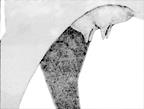
|
Very small | 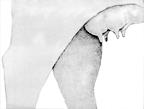
|
| 7 | Tight | 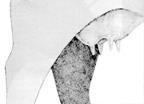
|
Small | 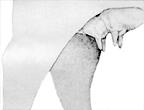
|
| 5 | Intermediate | 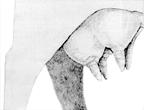
|
Intermediate | 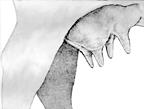
|
| 3 | Pendulous | 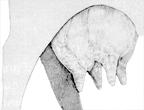
|
Large | 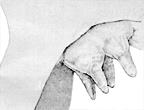
|
| 1 | Very pendulous | 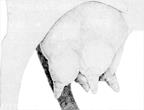
|
Very large, misshapen | 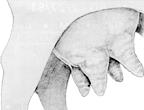
|
Images used courtesy of the American Hereford Association.
References
Bradford, H. L., D. W. Moser, J. Minick Bormann, and R. L. Weaber. 2015. Estimation of genetic parameters for udder traits in Hereford cattle. J. Anim. Sci. 93:2663–2668.
Frisch, J. E. 1982. The use of teat-size measurements or calf weaning weight as an aid to selection against teat defects in cattle. Anim. Prod. 32:127–133.
Kersey DeNise, R. S., D. E. Ray, A. M. Lane, V. L. Rundle, and M. Torabi. 1987. Relationships among udder shape, udder capacity, cow longevity and calf weights. J. Anim. Sci. 65:366–372.
Riley, D. G., J. O. Sanders, R. E. Knutson, and D. K. Lunt. 2001. Comparison of F1 Bos indicus × Hereford cows in central Texas: II. Udder, mouth, longevity, and lifetime productivity. J. Anim. Sci. 79:1439–1449.
Tolleson, M. W., C. A. Gill, A. D. Herring, P. K. Riggs, J. E. Sawyer, J. O. Sanders, and D. G. Riley. 2017. Association of udder traits with single nucleotide polymorphisms in crossbred Bos indicus-Bos taurus cows. J. Anim. Sci. 95:2399–2407.